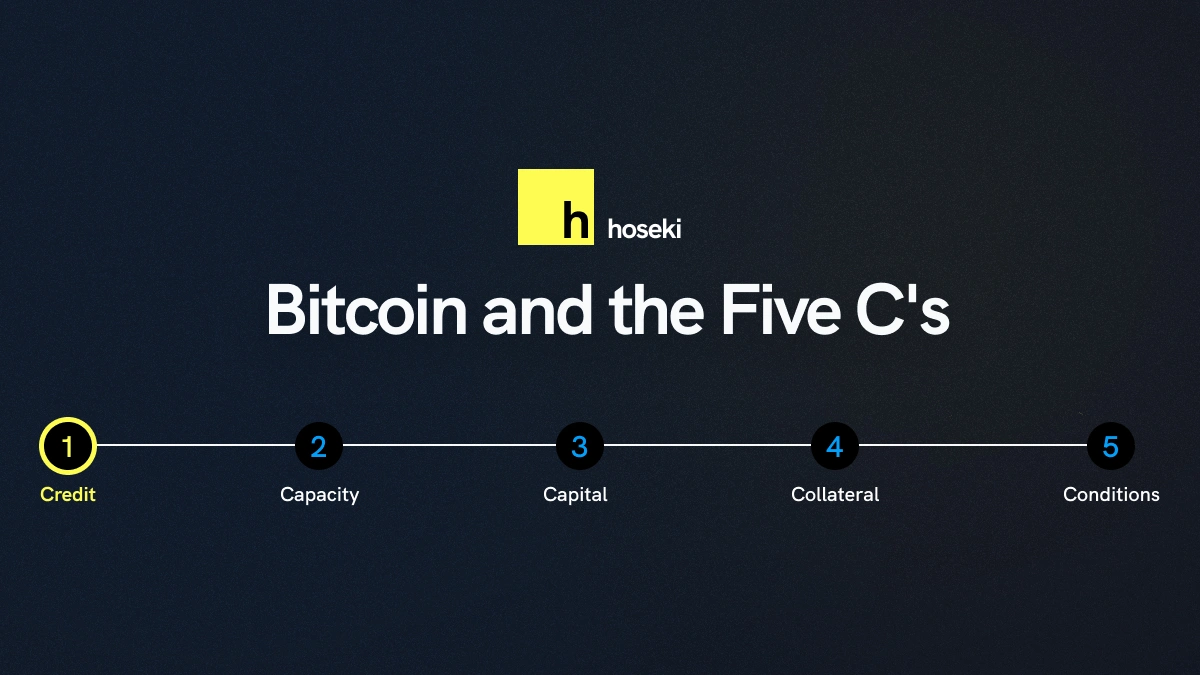
Bitcoin and the Five C's: Credit
As discussed in part one of this series: the average American learns fairly early on the importance of maintaining a solid credit history and subsequently earning a respectable credit score. But the mechanisms that determine a credit score are often mysterious and opaque.
A Brief History of Credit Reporting
The consumer credit reporting industry in the U.S. dates back to the 1800’s and at one point consisted of over 1,000 credit bureaus. Back then, credit reports included invasive details from a consumer’s personality traits all the way down to details about their health. What could go wrong? With so many bureaus reporting on such ambiguous criteria, lenders had to battle horrible inefficiencies and would-be borrowers had to navigate frustrating subjectivity when applying for a loan. By 1970, lawmakers sought to empower consumers with the ability to address errors in reporting and modernize the credit reporting industry through the Fair Credit Reporting Act.
Today, there are 3 primary consumer reporting agencies (CRAs): Equifax, TransUnion and Experian. These credit bureaus are private, for-profit entities that have no formal relationship with banks or government agencies, despite their outsized influence over the daily affairs of every American. Their primary responsibility is to gather information from financial institutions about every person who has a social security number and subsequently produce a comprehensive credit report upon request.
Practically, this means that when John Doe applies for a credit card through ACME Bank, one of the first things that happens is ACME reaches out to Equifax, TransUnion and Experian to ask about John’s credit history by running a credit check. Depending on their decision, they also report back to the CRAs whether or not the credit request was approved or denied. If approved, a new entry is created within John Doe’s credit file and tracking on John’s repayment begins. ACME communicates the details of the credit card: revolving or installment, total credit limit, account numbers, etc. From there, every month ACME notifies the CRAs of John Doe’s activity: his credit card balance, if he made his monthly payment and whether or not that payment was made on time. Typically, a creditor only reports a payment as “late” if it is at least 30 days past due. So while ACME may charge a late fee if a payment is just 1 day late, it won’t actually impact Mr. Doe’s credit rating unless it goes past 30 days.
This process is followed for almost every significant financial event in John Doe’s life. Each entry contributes to a comprehensive credit report which is further distilled and presented as an overly simplistic numeric credit score that ranges from 300-850. This score is known as FICO, named for the statistics company Fair, Isaac and Company that invented it. Typically, each CRA has a slightly different score for each consumer, and a lender who utilizes all three agencies for qualifying a buyer will rely on the middle of the 3 scores for the purposes of underwriting. So if John Doe has a 677 with Equifax, a 701 with TransUnion and a 689 with Experian, ACME bank will most likely consider his FICO score to be 689.
From the lender’s standpoint, this is an extremely convenient way to somewhat reliably assess the creditworthiness of their potential borrower. If a borrower has historically been consistent in making payments, if they have a long track record of having loans in good standing and if they are not over-extended with debt relative to their income, their FICO score is likely to be in the high 700’s or even 800’s. From the consumer’s perspective, maintaining a pristine credit history and obtaining a high credit score, also makes them a prime candidate for securing financing with the most favorable terms.
The prevailing FICO system leaves a lot to be desired and certainly has its shortcomings. As mentioned above, there is often very little recourse for a consumer who has erroneous or inaccurate information reflected on their credit report. Good luck challenging what ACME Bank has reported to Experian! But outside of these limitations, the long track record and consistency of the FICO system provides a level of familiar comfort for lenders that is not likely to go away any time soon.
FICO Scores Under a Bitcoin Standard
Humanity currently inhabits a debt-based monetary system which means the need to efficiently quantify who should be eligible to borrow and who should be excluded from such a privilege, will continue to be a cornerstone of lending. However, as society begins to transition to a digital world, outdated and subjective models like FICO seem to be ripe for innovation. It’s difficult to fully imagine what will be possible under a bitcoin standard, but we have some clues about the improvements that are available for lenders when evaluating a borrower’s creditworthiness. The mental models will continue to evolve as the asset matures, but the idea of replacing a highly centralized, low privacy and inconsistent mechanism like CRAs and FICO seem incompatible with many of Bitcoin’s core principles.
When it comes to this “C”, the more worrisome outcome is that an even more centralized and invasive credit reporting system will emerge if governments are successful in implementing a Central Bank Digital Currency (CBDC). It is conceivable that CBDCs could usher in an expansive social credit system and begin including factors such as whether or not a parking ticket was paid or if an unpopular opinion was posted on social media.
While bitcoin wasn’t necessarily designed to address the CRA and FICO issue, it does incentivize consumer behavior that moves us away from an economy that is built entirely on debt to a more sound economy where borrowing and lending is more transparent and disciplined. This becomes more apparent when unpacking the next “C,” which is a borrower’s capacity.